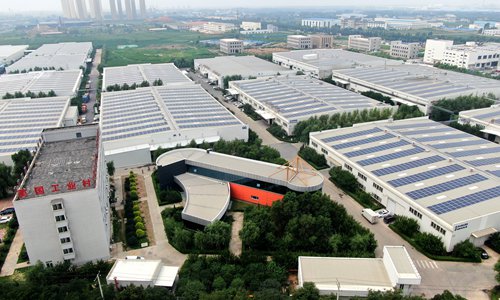HOME >> BUSINESS
Liaoning grows, but broad NE China revival elusive
Source:Global Times Published: 2019/7/24 21:07:39

A bird's-eye view of an industrial park in Shenyang, Northeast China's Liaoning Province on July 18. Photo: IC
The GDP of Northeast China's Liaoning Province increased 5.8 percent year-on-year in the first half of 2019, Liaoning Provincial Bureau of Statistics announced on Wednesday. But analysts said that an overall revival of Northeast China remains an elusive goal, because the other two provinces in the region are lagging Liaoning and the national average.Northeast China, the country's old industrial base, consists of Liaoning, Jilin and Heilongjiang provinces. The economy of Jilin grew by 2.4 percent and Heilongjiang grew by 5.3 percent year-on-year in the first quarter of 2019, below the national rate of 6.4 percent, according to the National Bureau of Statistics (NBS). Liaoning's GDP was up 6.1 percent, the first time in four years it achieved 6-percent-plus growth.
"Liaoning's growth rate, though lower than the national average, is hard-won and shows an economic recovery," Liang Qidong, researcher at the Liaoning Academy of Social Sciences, told the Global Times on Wednesday. "It's hard to say that Northeast China has seen a stable economic revitalization as Jilin and Heilongjiang have failed to recover," said Liang.
Since 2014, Northeast China has been struggling for revival. But it's been hard to achieve. Heilongjiang's GDP growth in the first quarter of 2019 was the third-lowest among China's 34 provincial-level administrative units, and Jilin placed last.
"The two provinces should learn from their peer. Liaoning achieved consecutive increases in its growth rate with steady, sound development, making a turnaround from contraction in 2016. That's huge progress," Liang said.
"Reforms and measures rolled out by central government in 2016 started working to revitalize the region, which was struggling with industrial decline, falling investment and a unfriendly business environment. A series of support policies were released, a free trade zone was set up in Liaoning, administration was streamlined and the business environment improved," the Xinhua News Agency reported.
"Liaoning's economic growth benefited from high-technology industry, industrial transformation and opening-up," said Liang.
Technology enterprises contributed to Liaoning's growth with more than 1,000 new high-technology companies established in Liaoning last year, Xinhua reported. The Huawei Artificial Intelligence industry base and JD's digital economy industrial park were newcomers.
The added value of high-technology manufacturing above the provincial scale in 2018 increased by 19.8 percent year-on-year, with investment up by 8.2 percent, according to the Liaoning statistical office. The output of new-energy vehicles expanded 4.7 times and the output of industrial robots rose by 18 percent. The output of optical fiber cables increased by 12.5 percent.
"Industrial transformation is helping traditional industries in Liaoning develop in a sustainable way," Liang said. "For example, despite the reduction of corn planting area of 776,000 mu (517 square kilometers), the grain yield in Liaoning is still stable at a high level, reaching 21.92 million tons by optimizing agricultural technologies."
"Liaoning is open to foreign investment that will tap into the potential of the revitalization of the old manufacturing base," Liang added.
BMW Brilliance Automotive, the German automaker's Chinese joint venture, opened a third plant in Shenyang, capital of Liaoning Province, in October 2018. That move made the company the first beneficiary after China substantially eased foreign ownership limits in the auto industry, according to a statement of the State Council.
Posted in: ECONOMY